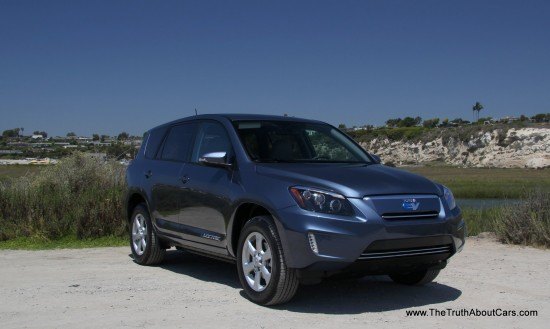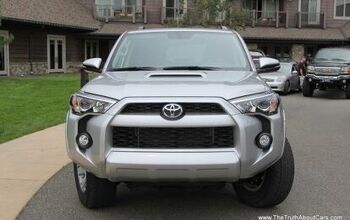Pre-Production Review: 2013 Toyota RAV4 EV

With California’s Zero Emissions Vehicle mandate looming it is only a matter of time till we see an EV from each of the major players in the California market. Nissan has the Leaf, BMW has the Active E, GM has the Volt and Honda electrified a Fit and Ford has electrified everything that isn’t nailed down. That brings us to the elephant in the room: Toyota. To give us some insight into Toyota’s CARB (California Air Resources Board) compliance plans and to see the fruits of the unlikely Toyota/Tesla marriage, Toyota flew us to sunny Southern California to sample the 2013 RAV4 EV.
Toyota tells us the RAV4 was selected for the same reason they electrified the old RAV4 back in 1997, the platform was able to handle the weight of the drivetrain without much modification. Essentially what we have on the outside of the RAV4EV then is the body of a RAV4 V6 with different bumper covers, headlamps and a new rear spoiler. The overall look is simple, clean and perfectly normal compared to the Nissan LEAF’s bubbly sheetmetal. During our time with the RAV4 EV no heads turned, nobody pointed and smiled. This truly is the sleeper EV.
The changes made to the RAV4 for EV duty are all “additive” meaning it runs on the same production line as the V6 and simply has additional things bolted on like extra reinforcements, mounting bars for the EV drivetrain, etc. These minimal changes seem logical when you consider that Toyota is hedging their bet in the EV game by working with Tesla to get the RAV4 EV to market in around 20 months while at the same time developing the iQ EV completely in-house.
Interior
The inside of the RAV4 EV is pure mid-market CUV, right from the hard plastic dash to the chunky leather steering wheel and the well placed Big-Gulp holders. To make EV owners feel special, Toyota changed the seating surfaces to SofTex (a faux-leather) with a honeycomb weave fabric insert, borrowed the Prius’ electronic shifter, extended the size of the seat heating zones and installed an all-new gauge cluster and infotainment system. Because the batteries are located completely under the RAV4 EV, the seating positions are unchanged and the rear seats retain their reclining feature as well as their fold-flat ability. With the seats duly folded cargo room grows from a standard 37 cubes to an impressive 73 cubes. Should that not be enough storage for you, the under-floor cargo “cubbies” haven’t been converted to batteries. As you would expect, Toyota ditched the power driver’s seat due to weight considerations so be sure you’re happy with the seat height before you buy.
Toyota chose the RAV4 EV as a sort of production “test bed” for technologies that will eventually trickle down to other products if they aren’t vilified by the press if the public takes to them. The first change is a new climate control interface that ditches the majority of the physical buttons for a (nearly) seamless touch sensitive panel. I’m not sure if I like the lack of haptic feedback on these systems, but Toyota tempers this with a snazzy high-res LCD for climate information.
Infotainment
Toyota seems to be in a “button minimalism” binge lately and nowhere is that more obvious than on the new 8-inch Entune radio in the photo above. Want to guess how you adjust the volume or change tracks? We needed Toyota engineer to show us as well. Thankfully the intuitive steering wheel controls remain unchanged.
The new 8-inch system is very responsive and builds on Toyota’s last generation of Entune products. In addition to the larger screen, the graphics and touch screen have been improved, allowing you to drag the map and volume slider and not “clicking” it. In terms of size, the 8-inch screen puts Toyota just behind Chrysler’s 8.4 inch UConnect system. In terms of functionality, this generation Entune system comes a close second to Ford’s MyFordTouch system now that Toyota has integrated voice command of your USB/iDevice music player.
Drivetrain
Under the hood of the RAV4 EV you will find the reason we hopped on a 45 minute flight: the motor from a Tesla Model S. Say what? Yep, the development timeline on the RAV4 EV was able to be so short partly because Toyota worked on the car in parallel with Tesla working on the drivetrain, but also because the RAV4 is using “off the shelf” Tesla parts under the hood. Wait! The Model S produces 362HP and 325 lb-ft and the RAV4EV is rated for 154HP and 273 lb-ft. What gives? The simple answer is of course: would you want 362HP in a FWD SUV? No, I didn’t think so.
The more complex answer is that while the motor could put out more power, the battery pack and DC/DC converter in the RAV4 isn’t designed to provide that kind of sustained output. In addition to the motor sharing, the RAV4’s charger and DC conversion circuitry are essentially the same unit as the Model S but adapted to the RAV4. Likewise the single speed transmission is very similar but the gearset was redesigned for a front mounted, FWD arrangement. As it is, the system has to keep the torque controlled when starting, so you don’t peel out every time, to that end torque is normally restricted to 218 lb-ft unless you select the Sport mode that allows access to all 273 (and raised the top speed limiter to 100MPH.)
Part of the reason the RAV4 was selected was the popularity of CUVs, the other reason was the ground clearance and chassis design of the RAV4 made fitting the 41.8kWh battery pack (slightly larger than the base Model S) a “bolt-on” affair. While the pack is not the same one used in a Tesla model, as with the other systems the D-cell sized batteries that make up the pack are produced by Panasonic.
Drive
Out on the road, the RAV4 EV drives like a quiet RAV4 V6 with a CVT, thanks to the constantly available torque. Don’t let the horsepower deficit deceive you, 0-60 happens in 6.8 seconds in Sport mode and about a second longer in the torque-reducing normal mode. This is essentially the same as the 269HP RAV4 V6, and quite fast for an EV of any description.
With this kind of forward thrust, FWD and low rolling resistance rubber, torque steer is present, fairly well controlled and strangely entertaining. Front-drive hoons will weep, sadly Toyota seems to have done an excellent job with the traction control system limiting one-wheel-peel to full-throttle turns only.
The big news for the RAV4 EV is: there’s not much to say. While most EVs drive like underpowered vehicles with strangely little off-the-line thrust, plenty of motor whine, grabby regenerative braking and peculiar throttle mapping, the RAV4 EV just drives like a fairly powerful mid-market CUV.
Charging
Like all EVs, charging is the biggest limiting factor for most owners rather than absolute range. Depending on how you drive the RAV4 and whether you are using the heater or the A/C, you can expect between 65 and 120 miles out of your electric crossover before you have to plug it in. With a 41.8kWh battey and a 10kW charger on board, charging your EV is more complicated than with the Nissan LEAF. Why’s that? Let’s dig in.
When the Nissan LEAF and Chevrolet Volt came on the scene two years ago there was a veritable renaissance in the public EV charging network. Prior to these two volume players (and prior to the J1772 standard) EV charging stations were few, far-between and an odd mishmash of 120V plugs, Avcon connectors and various incompatible inductive paddles.
Two years later and California has been united with one plug to rule them all, except that the majority of these charging stations seem to be designed to support a maximum charge rate of 6.6kWh with a fairly large share of 3.3kWh chargers. As a result, plugging your RAV4 EV’s 9.6kW charger into one of these stations would result in charging times that are much longer than the quoted 5-6 hours. Toyota tells us charging time brakes down like this: a full charge at 9.6kW takes 5-6 hours from empty, 7.2kW 8 hours, 6.6kW 9 hours, 3.8kW 15 hrs and should you only have your 120V “emergency cord” handy, the 1.4kW charge will take 52 hours. Ouch.
Like most EVs, don’t even think about buying a RAV4 EV unless you’re also buying a home charging station to plug it in. Toyota’s partner Leviton will sell and install one for $1,500 (not including permits), but you might want to explore that further before you buy an EV, especially if you live in an older home. Be sure to also check with your utility company to see if you qualify for lower “EV rates” or you may see your electric bill rise much higher than you’d think due to those pesky “baseline” charges in California.
If you’re thinking about upgrading from your LEAF to a RAV4 EV, just remember that in addition to your home charging likely being undersized and needing to be replaced, Toyota decided not to support the CHAdeMO DC fast charging standard. Two years ago when the RAV4 started development there was no national standard and there were no CHAdeMO stations in the country so the engineers decided to skip DC charge support until there was a standard. Since there are now (finally) several stations in the Bay Area and a number sprouting up in Southern California, SAE standards aside, it would seem the DC charging standard has been decided but this generation of RAV4 decided to skip the party. Charge convenience aside, you should know that DC quick charging is hard on a battery so if you want your RAV4 to last, then this isn’t really an issue.
Price
If you are between 45 and 65, married, a two car family and have plenty of expendable income, then this RAV’s for you. If you’re outside this demographic, the $49,800 MSRP will cause some serious sticker shock. Since the RAV4 EV comes only one way (fully loaded) and there are only 2,600 going to be built over three years, you’re not only paying for the extremely expensive drivetrain, but for the scarcity of the vehicle. While Toyota would not comment officially or unofficially on the cost of the drivetrain, I detected a “spot on” glance from one of our minders when I surmised that the EV components, excluding R&D costs was somewhere uncomfortably close to the entire $49,800 sticker price of the RAV4 EV. If you choose to think you’re getting a deal, good for you. For the rest of you: lease the EV so you don’t have to worry about little things like battery degradation. Yes there is a California rebate of $2,500 available and a $7,500 tax credit, but depending on your tax situation the IRS may not give you much back. One possible justification for spending about $25,000 more on the EV than the four-cylinder RAV4 is California’s “permanent” carpool access stickers. On my daily commute using the carpool lane solo saved me 30 minutes a day. How much is that worth to you? Your answer needs to be: more than $25,000.
Who is it for?
Excellent question dear reader. As we said, Toyota is targeting a married, affluent demographic in California. To me, this makes some sort of sense. There is just one problem, it seems to me that Toyota and Tesla are fishing in the same, very small, pond with the Model S at $57,400 and the RAV4 EV at $49,800. Either way, if you want some Tesla love on the cheap, the RAV4 EV is the cheaper option.
Why should I care? I’m not buying an EV.
Toyota is using the RAV4 EV as publicly available test vehicle in some ways. How well does this relationship with Tesla go? How does Tesla handle the supply, assembly and warranty side of the RAV4 EV? How do people like the new Entune system? What do real-world EV owners think of the product? All these questions are why the RAV4 EV exists. BUT, CARB’s ZEV mandate is the reason Toyota is willing to lose plenty of cash to answer them. The RAV4 is a large step in the right direction for the EV niche as it is a perfectly practical, perfectly normal feeling CUV. While 99.9% of readers will never end up with one, you’ll likely benefit from what is learned in this process.
Toyota flew me to Newport Beach, fed me a snazzy dinner and a meat-free continental breakfast for this review. Not a fan of our Facebook page? Too bad, if you liked us on FaceBook you’d know what we have on the front burner. Get on, get social and tell us what you want to see. Subscribe to our YouTube channel while you’re at it.

More by Alex L. Dykes
Latest Car Reviews
Read moreLatest Product Reviews
Read moreRecent Comments
- Dave M. I'm sorry to see any storied name go away. The lifespan of the Malibu has fit perfectly in my lifetime years-wise. Some of the highlights include the first and second generations, the '78 revamp (very clean design), and the 2005 generation. Ford, GM and Mopar gave this segment away by allowing Toyota and Honda a foot in the door and then always having to play catch-up. How hard is it to make a truly competitive sedan at a profit? Obviously, Japan Inc. figured it out.I've driven a few rentals these past years; the Malibu got the job done but honestly the Passat and Altima were my rental preferences.
- Kcflyer actually yes. It's a shame that a product this uncompetitive can still outsell GM's entire EV offerings. Those products have had billions thrown at them. Imagine how nice the new Malibu, Impala, SS, and Lacrosse would be with that kind of commitment.
- 3SpeedAutomatic Nope....
- Bd2 Looking forward to flooding the rental lots with Hyundai and Kia models, this is just one obstacle now eliminated.
- Kcflyer keep the color. lose the stupid front design. make it reliable, at least as reliable as a base 911. Then and only then is it somewhat worthy of that price.



























































































Comments
Join the conversation
I'm a fan of electric cars, but not those currently being produced. They are, in a word, unacceptable. And it's all about the batteries - they are ultra expensive, have way to little capacity, which shrinks considerably as the years roll by, take ridiculously long to recharge,and are fragile (remember bricking Tesla roadsters?). Nor would any competent electrical engineer ever, even in his most insane moments, choose laptop cells (about 3800 of them) to hold a mere 41 kWhrs. Even the DIY EV guys laugh about that. But this car's fatal flaw is that it is totally one-dimensional - an around town car that can't travel. But, on the other hand, neither can any of Tesla Model S versions, at least not if you plan on travelling more than 600 miles,which means the Interstates (the 85kWh Model S has a severe aversion to Interstate speeds, even with a brand new $40,000 battery). I have no clue as to why Tesla is even building their 40kWh Model S - perhaps so they can claim that their cars start at $57K ?
If you want a 100 EV mile SUV, that carries over 70 cu ft of cargo, does 0-60 in about 7 seconds, you have exactly one choice on the market Compared to the less-expensive Nissan Leaf, it is infinitely roomier, for people and cargo. It is much faster, and may have a noticeably better real-wrold EV range. You get what you pay for. BD